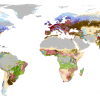

Foodscapes - A global clustering of terrestrial food production systems (Foodscapes)

Martin Jung
Senior Research Scholar (BEC)

Michael Obersteiner
Principal Research Scholar (EM)

Christian Folberth
Senior Research Scholar (AFE)